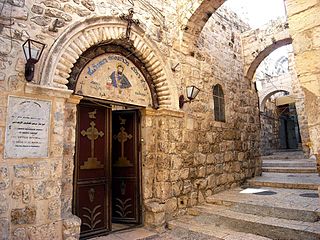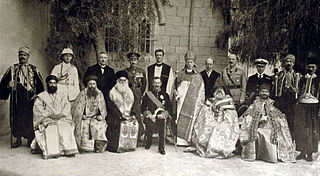Related Research Articles

Dayro d-Mor Mattai is a Syriac Orthodox Church monastery on Mount Alfaf in northern Iraq, 20 kilometers northeast of the city of Mosul. It is recognized as one of the oldest Christian monasteries in existence and the oldest Syriac Orthodox monastery in the world.
Athanasius II Baldoyo, also known as Athanasius of Balad, and Athanasius of Nisibis, was the Patriarch of Antioch and head of the Syriac Orthodox Church from 684 until his death in 687.
Ignatius Isaac II was the Patriarch of Antioch and head of the Syriac Orthodox Church from 1709 until his resignation in 1723.
Ignatius Jacob I, also known as Jacob al-Khuri or Jacob of al-Nabk, was the Patriarch of Antioch and head of the Syriac Orthodox Church from 1510/1512 until his death in 1517/1519.
Ignatius Hidayat Allah was the Patriarch of Antioch and head of the Syriac Orthodox Church from 1597/1598 until his death in 1639/1640.
Marutha of Tikrit was the Grand Metropolitan of the East and head of the Syriac Orthodox Church of the East from 628 or 629 until his death in 649. He is commemorated as a saint by the Syriac Orthodox Church.
Athanasius I Gammolo was the Patriarch of Antioch and head of the Syriac Orthodox Church from 594/595 or 603 until his death in 631. He is commemorated as a saint by the Syriac Orthodox Church in the Martyrology of Rabban Sliba, and his feast day is 3 January.
Iwannis I was the Patriarch of Antioch and head of the Syriac Orthodox Church from 739/740 until his death in 754/755.
Athanasius IV Salhoyo was the Patriarch of Antioch and head of the Syriac Orthodox Church from 986/987 until his death in 1002/1003.
Ignatius II was the Patriarch of Antioch and head of the Syriac Orthodox Church from 878 until his death in 883.
Dionysius II was the Patriarch of Antioch and head of the Syriac Orthodox Church from 896/897 until his death in 908/909.
Athanasius VI bar Khamoro was the Patriarch of Antioch, and head of the Syriac Orthodox Church from 1091 until his death in 1129.

The Monastery of Saint Mark the Evangelist and the Virgin Mary is a Syriac Orthodox monastery in the Armenian Quarter of the Old City of Jerusalem and residence of the Syriac Orthodox Archbishop of Jerusalem. It is believed to be located on the site of house of Mary, mother of Mark the Evangelist; Syriac Christians believe that it was the place where the Last Supper was shared by Jesus and the Twelve Apostles, where the Apostles hid after the Passion and Crucifixion of Jesus, and where Jesus appeared to the Apostles after the Resurrection. The place claims to be the first church in Christianity. The monastery consists of the main church of Saint Mark and an adjacent chapel of Saint Behnam.
Ignatius George II was the Patriarch of Antioch and head of the Syriac Orthodox Church from 1687 until his death in 1708.
Dionysius bar Masih was an illegitimate Maphrian of the East of the Syriac Orthodox Church, and rivalled Gregorius Jacob, the legitimate Maphrian, from 1189 until his death in 1204.
John XI bar Mawdyono, also known as Yuhanna Modyana, was the Patriarch of Antioch, and head of the Syriac Orthodox Church from 1130 until his death in 1137.

In the Syriac Orthodox Church, the Archbishop of Jerusalem today bears the additional title of Patriarchal Vicar of the Holy Land and Jordan. The see is currently held by Anthimos Jack Yakoub.
Basil bar Shumna was the Syriac Orthodox metropolitan archbishop of Edessa from 1143 until his death. He wrote a Syriac chronicle covering the years from 1118 until his death, which is now lost but was used as a source by Michael the Great and the anonymous author of the Chronicle of 1234.
The Mor Bar Sauma Monastery was a Syriac Orthodox monastery near Malatya in Turkey. The monastery served as the regular patriarchal residence from the eleventh century until the thirteenth century, and was eventually abandoned in the seventeenth century. It produced five patriarchs and forty-three metropolitan bishops. Between 1074 and 1283 several synods took place at the monastery.